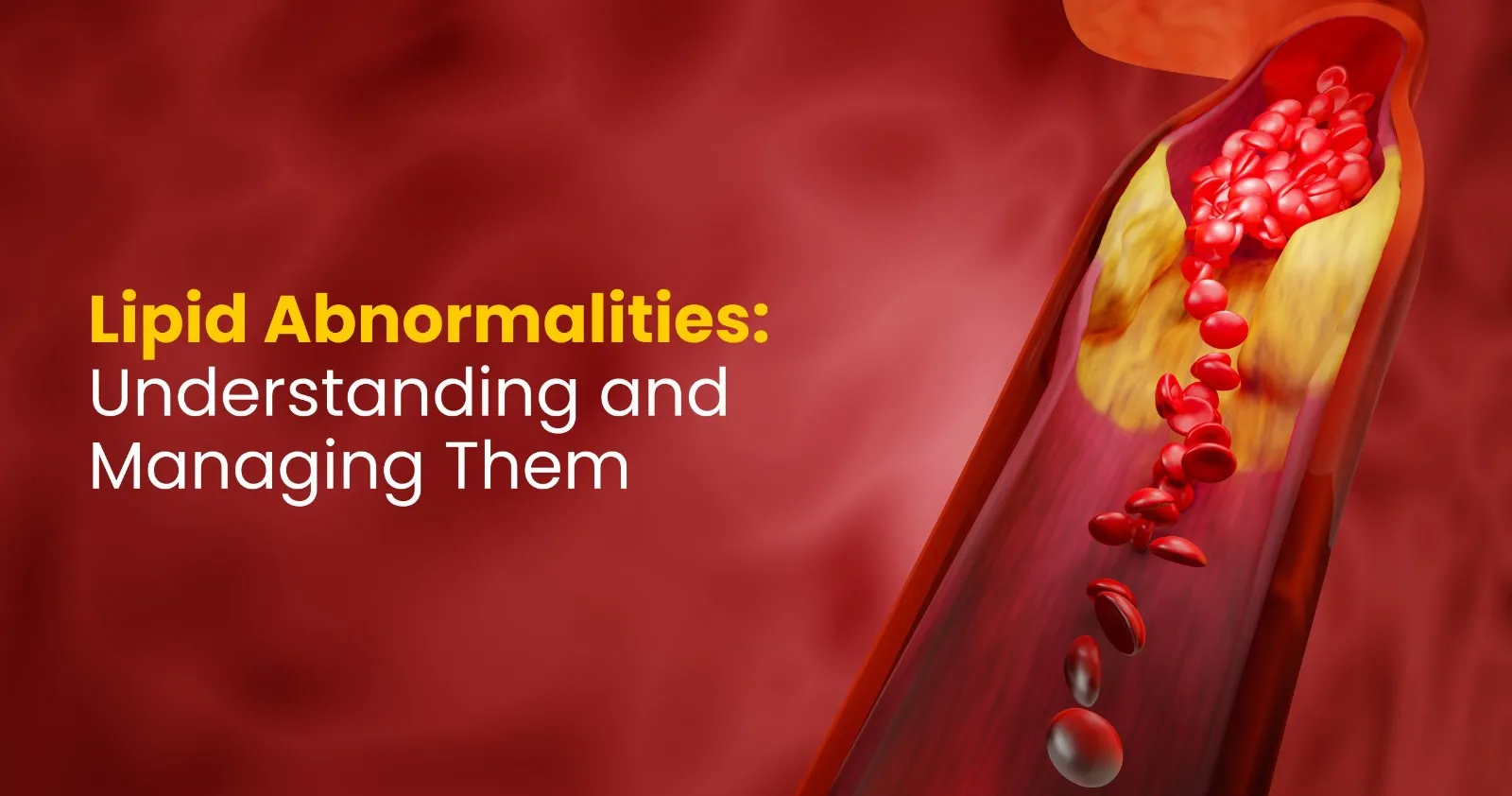Lipid Abnormalities: Understanding and Managing Them
Oct 12, 2023

Lipids, often referred to as fats, are essential components of our body. While they play critical roles in various bodily functions, an imbalance in lipid levels can lead to lipid abnormalities, posing serious health risks. In this blog, we will delve into the causes, risk factors, and management of lipid abnormalities. We will also discuss when it's crucial to seek medical attention and empower you with essential knowledge about lipid health.
Understanding Lipid Abnormalities
Lipid abnormalities, also known as dyslipidemia, occur when there is an imbalance in the levels of lipids in the blood. The primary lipids of concern include cholesterol and triglycerides. Understanding these lipids is crucial for grasping the concept of lipid abnormalities:
- Cholesterol
Cholesterol is a waxy, fat-like substance that is vital for the formation of cell membranes and the production of certain hormones. It is carried in the blood by lipoproteins, primarily low-density lipoprotein (LDL) and high-density lipoprotein (HDL). LDL cholesterol is frequently mentioned as "bad" cholesterol as high levels of it can cause the buildup of plaque in the arteries. Alternatively, HDL cholesterol is considered "good" cholesterol as it supports the removal of LDL cholesterol from the bloodstream.
- Triglycerides
Triglycerides are one more type of fat found in the blood. They are stored in fat cells and serve as a source of energy for the body. Raised triglyceride levels, can also increase the risk of heart disease.
Understanding what lipid abnormalities are helps us make better choices for our heart's health. With this knowledge, we can take steps to keep our hearts healthy and work closely with doctors to manage and reduce the risks of lipid problems. Now that we are acquainted with the lipids let us understand the causes of lipid abnormalities.
Causes of Lipid Abnormalities
Lipid abnormalities can result from various factors, including:
- Poor Diet: Consuming a diet high in saturated and trans fats, as well as excessive refined sugars and carbohydrates, can lead to elevated LDL cholesterol and triglyceride levels.
- Sedentary Lifestyle: Lack of physical activity can contribute to weight gain and raise triglyceride levels while lowering HDL cholesterol.
- Genetics: Some individuals may inherit a genetic tendency for lipid abnormalities, making them more susceptible to high cholesterol or triglycerides.
- Obesity: Excess body weight, especially abdominal obesity, is associated with higher levels of triglycerides and LDL cholesterol and lower levels of HDL cholesterol.
- Medical Conditions: Certain medical conditions such as diabetes, hypothyroidism, and kidney disease can disrupt lipid metabolism, leading to dyslipidemia.
- Medications: Certain medications, including antipsychotics, corticosteroids, and diuretics, can negatively affect lipid levels.
Recognizing the underlying causes is the first step toward effectively managing and mitigating the risks associated with dyslipidemia, ultimately safeguarding your heart health.
is the first step toward effectively managing and mitigating the risks associated with dyslipidemia, ultimately safeguarding your heart health.
Risk Factors for Lipid Abnormalities
Several factors increase the risk of developing lipid abnormalities, including:
- Family History: A family history of high cholesterol or lipid abnormalities can incline individuals to similar canditions.
- Age and Gender: Cholesterol levels tend to rise with age, and men often have higher cholesterol levels than women, although this difference diminishes ofter menopause.
- Smoking: Smoking damages blood vessels and lowers HDL cholesterol, increasing the risk of lipid abnormalities.
- Uncontrolled Diabetes: Poorly managed diabetes can lead to lipid abnormalities.
- High Blood Pressure: Hypertension is often associated with lipid abnormalities.
- Poor Diet and Physical Inactivity: An unhealthy lifestyle can contribute to the development of lipid abnormalities.
Understanding the risk factors for lipid abnormalities is crucial for early detection and prevention. By addressing these factors and adopting a heart-healthy lifestyle, individuals can reduce their risk of developing dyslipidemia and its associated health complications.
When to See a Doctor?
Monitoring your lipid levels is essential for maintaining cardiovascular health. You should not delay seeing a doctor if:
- You have a family history of cardiac problems or high cholesterol.
- You have risk factors such as diabetes, hypertension, or obesity.
- You experience chest pain, leg pain or shortness of breath, which may suggest cardiovascular problems related to lipid abnormalities.
- You are over 20 years old, and it is suggested to have your cholesterol levels checked once every five years.
- Your healthcare provider recommends routine lipid profile testing based on your medical history and risk factors.
Knowing when to seek medical attention for lipid abnormalities is essential for timely intervention and effective management. Regular monitoring and consultation with a healthcare professional can help individuals navigate their lipid health, reducing the risk of cardiovascular complications.
Summing Up!
Understanding lipid abnormalities is a crucial step toward maintaining heart health. By recognizing the causes, risk factors, and when to seek medical attention, you can take proactive steps to manage your lipid levels and reduce the risk of cardiovascular disease. Remember that a healthy lifestyle, including a balanced diet, regular physical activity, and appropriate medical management, can significantly contribute to better lipid health and overall well-being.
Take the first step towards a healthier heart by booking a diagnostic test today! Apollo Diagnostics has a comprehensive range of tests, world-class facilities, and an unwavering commitment to delivering the highest standards of care. Visit our website; whether it is a routine check-up or specialized tests, we are here to serve you!
FAQs
1. can I lower my cholesterol levels through diet and exercise alone?
Adopting a healthy diet and engaging in regular physical activity is crucial for managing lipid abnormalities. But sometimes, lifestyle changes alone may not be sufficient, especially if there is a strong genetic component or other underlying medical conditions. Your doctor may recommend medication to help control your cholesterol levels. Moreover, lifestyle modifications remain an essential part of any treatment plan.
2. What are the ideal cholesterol levels?
Optimal cholesterol levels may vary based on individual risk factors and medical history. But in general, healthy cholesterol levels should be as follows:
- Total cholesterol should ideally be less than 200 milligrams per deciliter (mg/dL)
- LDL cholesterol should preferably be less than 100 mg/dL
- HDL cholesterol should be greater than 40 mg/dL for men and greater than 50 mg/dL for women
- Triglycerides levels should not be more than 150 mg/dL
3.can children have lipid abnormalities?
Yes, children can develop lipid abnormalities, especially if they have a family history of dyslipidemia or other risk factors such as obesity or a poor diet. Pediatricians may recommend lipid screening for children and adolescents, particularly if there is a family history of early heart disease or other significant risk factors. Lifestyle modifications and, in some cases, medication may be prescribed to manage lipid abnormalities in children.
Related Blog Post
- Prevention is better than cure – Importance of regular master check
- IMPORTANCE OF REGULAR MEDICAL CHECKUPS
- Full Body Checkup – Advantages For Healthy Living
- Going for a Health Check - Points to be noted
- How Often Should You Go for a Health Check?
- Understanding Kidney Function: How KFT Tests Help Assess Renal Health
Blog Categories
- Child Health
- Mens Health
- Women's Health
- Mental Health
- Health Myths & Facts
- Fitness
- Nutrition/Recipes
- Remedies
- Weight Management
- Stress Management
- Health Supplements
- Addiction Management
- Disease Management
- Allergy
- Anemia
- Arthritis
- Asthma
- Autoimmune Diseases
- Blood Pressure
- Cancer
- Deficiencies
- Dengue/Malaria/Chikungunya
- Diabetes
- Eye Problems
- Heart Diseases
- Hepatitis
- HIV/AIDS/STD
- Hormonal Imbalance
- Infection/Flu/Viral
- Kidney
- Liver
- Menstrual Problems
- Pregnancy
- Skin & Hair Problems
- Stomach Ailments
- Thyroid
- Others
- Health Checkups
- Diagnostics/Pathology
- Lifestyle & Wellness
- Covid
- Medical Tests
- Cholesterol
- Health Tips
- Parent Care/Old Age
- Lungs
- Food Intolerance








